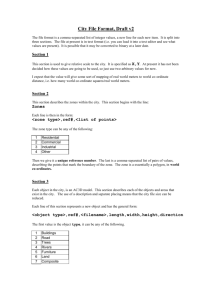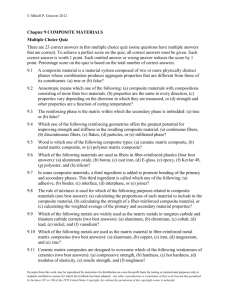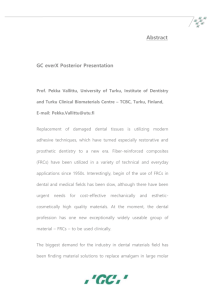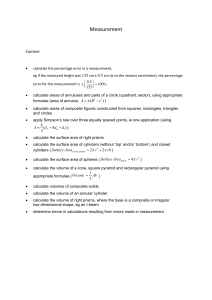Java Based Distributed Learning Platform
advertisement
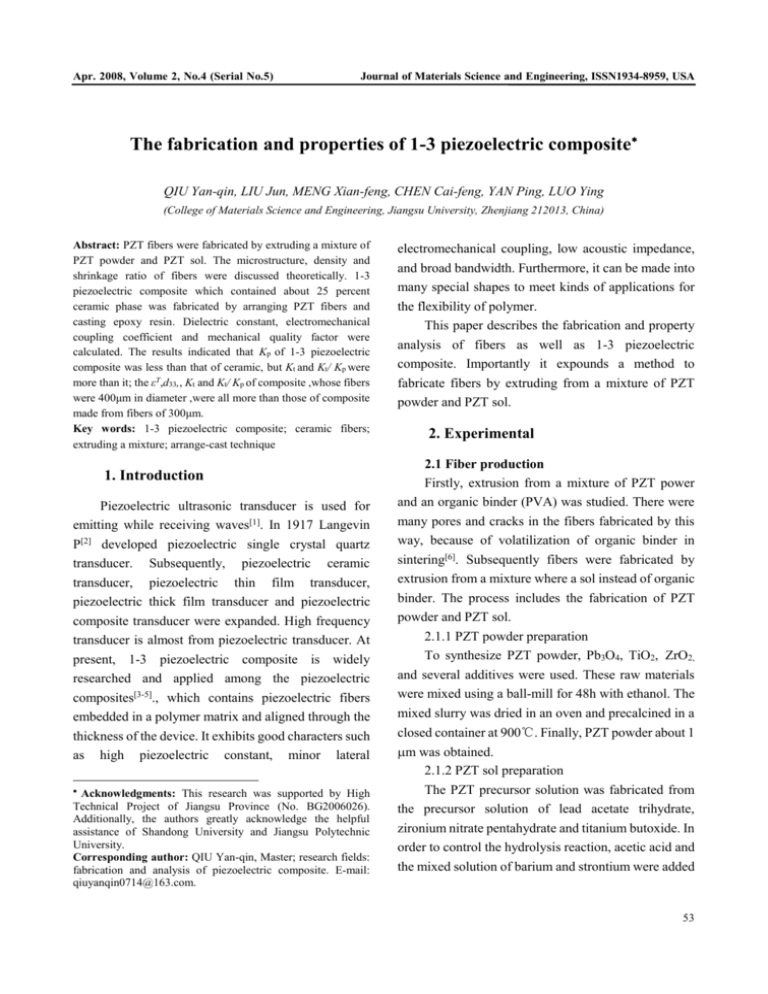
Apr. 2008, Volume 2, No.4 (Serial No.5) Journal of Materials Science and Engineering, ISSN1934-8959, USA The fabrication and properties of 1-3 piezoelectric composite QIU Yan-qin, LIU Jun, MENG Xian-feng, CHEN Cai-feng, YAN Ping, LUO Ying (College of Materials Science and Engineering, Jiangsu University, Zhenjiang 212013, China) Abstract: PZT fibers were fabricated by extruding a mixture of PZT powder and PZT sol. The microstructure, density and shrinkage ratio of fibers were discussed theoretically. 1-3 piezoelectric composite which contained about 25 percent ceramic phase was fabricated by arranging PZT fibers and casting epoxy resin. Dielectric constant, electromechanical coupling coefficient and mechanical quality factor were calculated. The results indicated that Kp of 1-3 piezoelectric composite was less than that of ceramic, but Kt and Kt/ Kp were more than it; the εT,d33,, Kt and Kt/ Kp of composite ,whose fibers were 400μm in diameter ,were all more than those of composite made from fibers of 300μm. Key words: 1-3 piezoelectric composite; ceramic fibers; extruding a mixture; arrange-cast technique 1. Introduction Piezoelectric ultrasonic transducer is used for emitting while receiving waves[1]. In 1917 Langevin P[2] developed piezoelectric single crystal quartz transducer. Subsequently, piezoelectric ceramic transducer, piezoelectric thin film transducer, piezoelectric thick film transducer and piezoelectric composite transducer were expanded. High frequency transducer is almost from piezoelectric transducer. At present, 1-3 piezoelectric composite is widely researched and applied among the piezoelectric composites[3-5]., which contains piezoelectric fibers embedded in a polymer matrix and aligned through the thickness of the device. It exhibits good characters such as high piezoelectric constant, minor lateral Acknowledgments: This research was supported by High Technical Project of Jiangsu Province (No. BG2006026). Additionally, the authors greatly acknowledge the helpful assistance of Shandong University and Jiangsu Polytechnic University. Corresponding author: QIU Yan-qin, Master; research fields: fabrication and analysis of piezoelectric composite. E-mail: qiuyanqin0714@163.com. electromechanical coupling, low acoustic impedance, and broad bandwidth. Furthermore, it can be made into many special shapes to meet kinds of applications for the flexibility of polymer. This paper describes the fabrication and property analysis of fibers as well as 1-3 piezoelectric composite. Importantly it expounds a method to fabricate fibers by extruding from a mixture of PZT powder and PZT sol. 2. Experimental 2.1 Fiber production Firstly, extrusion from a mixture of PZT power and an organic binder (PVA) was studied. There were many pores and cracks in the fibers fabricated by this way, because of volatilization of organic binder in sintering[6]. Subsequently fibers were fabricated by extrusion from a mixture where a sol instead of organic binder. The process includes the fabrication of PZT powder and PZT sol. 2.1.1 PZT powder preparation To synthesize PZT powder, Pb3O4, TiO2, ZrO2, and several additives were used. These raw materials were mixed using a ball-mill for 48h with ethanol. The mixed slurry was dried in an oven and precalcined in a closed container at 900℃. Finally, PZT powder about 1 m was obtained. 2.1.2 PZT sol preparation The PZT precursor solution was fabricated from the precursor solution of lead acetate trihydrate, zironium nitrate pentahydrate and titanium butoxide. In order to control the hydrolysis reaction, acetic acid and the mixed solution of barium and strontium were added 53 The fabrication and properties of 1-3 piezoelectric composite to the precursor solution. This starting solution was kept at 80℃ in a water-bath, and its concentration was enhanced by the volatilization of solvent and additives. The variables for controlling the hydrolysis reaction were the curing temperature and the amount of water and acetic acid. Till the spinnable concentration was about 1.35-1.6 mmol/g, the sol had already fabricated. 2.1.3 Fiber production The sol was adjusted by mixing it with the fabricated PZT powder (powder: sol=5-8:1 in molar ratio) in a breaker. The mixture was ground and pressed into many cakes, which can remove the pore in the mixture and increase its uniformity, density, and plasticity. The mixture was put into the extrusion apparatus and fibers were extruded through the spinnerets with different diameters holes. Then the extruded fibers were dried on an oblique glass panel for 48h and sintered at 1240℃ for 2h in a closed container where fibers were covered by the mixture of Pb3O4 and ZrO2. The procedure of fabrication of PZT fibers in this study was summarized in Figure 1. Lead acetate + MOE Zirconium nitrate + MOE Lead precursor solution Zirconium precursor solution Burium nitrate and strontium nitrate + water Titanium butoxide + MOE Titanium precursor solution PZT sol PZT powder Mixture (powder : sol=5~8:1) Sintering(1240℃) Fig. 1 drying The procedures of fabrication of PZT fibers The extruded fibers about several meters in length were attainable, which were flexile all the same after several hours. Figure 2 shows the SEM micrographs of green fibers. The powder and sol were mixed uniformly. Figure 3 shows the SEM micrographs of the sintered fibers. The micrographs show that the sintered fibers were polycrystalline, and had no defects such as pores or cracks. It was considered that the added sol, instead of organic binder which resulted in many pores and cracks in sintering stage, promoted the densification of fibers effectively. Table 1 shows the shrinkage ration and density of fibers 400 m in diameter extruded from the mixture of powder and 54 extruding PVA(A), and fibers extruded from the mixture of powder and sol (B and C), where the diameter of B and C are 300 m and 400 m, respectively. It can be concluded that density of the fibers fabricated by extrusion from a mixture of PZT power and PZT sol were promoted, because gel changed into oxide ceramic with the desired composition during the sintering stage. Table 1 Shrinkage ratio and density of fibers A, B and C Serial number Shrinkage ratio (%) Density (g/cm3) A 24.80 5.82 B 14.04 7.23 The fabrication and properties of 1-3 piezoelectric composite C 15.74 7.44 a b Fig. 2 Microstructure of the green fibers (a) diameter of 300μm (b) diameter of 400μm a b Fig. 3 Microstructure of fibers after sintering (a) diameter of 300μm (b) diameter of 400μm 2.2 Composite fabrication There are arrange-cast technique and dice-fill technique to fabricate 1-3 type piezoelectric composite. Dice-fill technique costs and wastes too much, and it’s difficult to fabricate higher volume fraction of the ceramic in composite. Arrange-cast technique is aligning fibers in the matrix firstly, and then casting epoxy resin to cover up the fibers. 1-3 type piezoelectric composite was obtained after curing[7-8] in an oven at 80℃ for 24h. The composite had a disk shape, 16mm in diameter and 1.6mm in thickness, where the ceramic volume fraction was about 25%. discontinuousness of fibers, uniformity of silver and intenerate of polymer, we determined the optimal polarizing condition: processed on time of 20-30 min, temperature of 100-120℃, and electric field of about 2.5-3 KV/mm. 2.3 Composite properties Piezoelectric constant d33 was tested by piezoelectric instrument. Low-frequency capacitance The arranging density of fibers, in diameter 300m and 400m, were about 3.6/mm2 and 1.3/mm2. After curing the composite needed to be polished to the desired thickness, and its thickness was even. The piezoelectric phase of specimen was visible. Then the two sides of composite were sputtered with silver. Here, the thickness of silver was about 0.01-0.02mm. Specimen was curing at 100-140 ℃ . Consider dielectric constant T, radial coupling coefficient Kp, thickness coupling coefficient Kt and mechanical quality factor were calculated, as shown in Table 2. In order to contrast, the parameters of PZT were also listed in Table 2. Cp, dielectric loss tan, resonant frequency fs, parallel resonant frequency fp and the minimum impedance | Zmin | of the composite were measured by precise impedance analyzer (4294A, Agilent). Relative 55 The fabrication and properties of 1-3 piezoelectric composite Table 2 Parameters of PZT ceramic and composite Serial number d33 (pC/N) T tan (%) Kp (%) Kt (%) Kt/Kp Qm A 469.0 3933.0 2.40 48.95 45.49 0.9293 65.80 B 168.2 275.1 3.76 35.79 51.49 1.4387 5.62 C 226.9 409.0 6.40 33.54 63.19 1.8840 1.48 2.3.1 Comparison in property between PZT ceramic and composite (1) Electromechanical coupling coefficient Table 2 shows radial coupling coefficient kp of 1-3 composite less than PZT ceramic, thickness coupling coefficient kt more than PZT ceramic, and its reachable Kt/Kp 1.8840, more than 0.9293 of PZT. Therefore, it made anisotropic property greater, the energy fastened on thickness mold and resonance enhanced in thickness. These were due to participation of polymer. The sound wave was weakened when it transmit from fibers of higher rigidity to flexile polymer. It continuously reduced as transmitting to other fibers. So resonance in radial was restrained and only wave in thickness was left. As a result there was more energy in thickness[9]. (2) Mechanical quality factor Qm=2πfsL/Rmin= fp 2/2πfs | Zmin | C0( fp2 - fs2) =fs/(f1/2 - f1/2)= fs/f1/2 Ex. (1)[10] Where |Zmin| is the minimum impedance, fs is resonant frequency and fp is parallel resonant frequency. As a supplement, there are main resonances in radial mold in PZT and in thickness in composite. Therefore, Qm were calculated through resonance in radial of PZT and in thickness of composite. Table 2 also shows Qm of composites are (5.62 and 1.48) less than that of PZT. It is known that the bandwidth (f1/2) of composite is extended. 2.3.2 Comparative of composites in property between fibers of different diameter Table 2 shows εT, d33, Kt and Kt/ Kp of composite whose fibers are 400m in diameter more than those of composite whose fibers are 300m in diameter. 56 However, Kp and Qm are contrary. The property of composites depended on its fibers mainly, as the ceramic volume fractions were in the same. It is known that the density of 400m diameter fiber was more than that of 300m diameter fiber as shown in Table 1. The probable reason was that pores in the thinner fibers were more than those in the fibers of 400m, because the more of surface of fibers touched the air, the heavier of volatilization of lead. Therefore, the piezoelectric property of composite where fibers were 300m in diameter was inferior to that of composite where fibers were 400m in diameter. 3. Conclusions (1) The PZT fibers fabricated by extrusion from a mixture of PZT power and PZT sol can meet fabrication of 1-3 composite, whose shrinkage were about 15%, density between 7.2 and 7.5. (2) The radial coupling coefficient kp of 1-3 composite was less than that of PZT ceramic while its thickness coupling coefficient kt and Kt/Kp were more than that of PZT ceramic. (3) The mechanical quality factor Qm of composite was less than that of PZT, so the bandwidth (f1/2) of composite was extended. (4) εT, d33, Kt and Kt/ Kp of composite whose fibers were 400m in diameter were more than those of composite whose fibers were 300m. However, Kp and Qm were contrary. Probably because volatilization of lead was more heavier in 300m diameter fibers. References: The fabrication and properties of 1-3 piezoelectric composite [1] [2] [3] [4] [5] [6] Halmshaw R. Non-destructive Testing. Edivard Arnold (Publishers) Ltd, 2003. Wotfgaog S, Nelson N H. Ultrasonic transducers for materials testing and their characterization. Physical Acoustics, 1979, 14: 277-406. Tressler James F, Alkoy Sedat, Newham Rbbert E. Piezoelectric sensors and sensor materials. Journal of Electrcceramics, 1998, 4: 257-272. WANG L. K, LI G., DU H. L., et al. Fabrication and performances of 1-3-2 piezoelectric ceramic/polymer composite. Rare Metal Materials and Engineering, 2006, 12(35): 511-513. LIAN L, Sottos N R. Dynamic surface displacement measurement in 1-3 and 1-1-3 piezocomposites. J Appl. Phys, 1998, 84(10): 5725-5728. QIU J. H., TAI J. J., Yoshimasa Kobayashi, et al. Fabrication of piezoelectric ceramic fibers by extrusion of Pb(Zr,Ti)O3 powder and Pb(Zr,Ti)O3 sol mixture. Smart Mater. Struct., 2003, 12: 331-337. (continued from Page 52) [11] XIAO P, XIAO M, GONG K. Preparation of exfoliated graphite/polystyrene composite by polymerization filling technique. Polymer, 2001, 42: 4813-4816. [12] WENGE Z, SHING C W, HUNG J S. Transport behavior of PMMA/expanded graphite nanocomposites. Polymer, 2002, 73: 6767-6773. [13] ZHENG W, WONG S C. Electrical conductivity and dielectric properties of PMMA/expanded graphite composites. Compos. Sci. Technol., 2003, 63: 225-235. [14] CHEN G H, WU C L, WENG W G.. Preparation of polymer/graphite conducting nanocomposite by intercalation polymerization. J. Appl. Polym. Sci., 2001, 82: 2506-2513. [15] DU X S, XIAO M, MENG Y Z. Direct synthesis of poly(arylenedisulfide)/carbon nanosheet composites via the oxidation with graphite oxide. Carbon, 2005, 43: 195-213. [16] CHEN G H, WENG W G, WU D. The electrical properties of graphite nanosheet filled immiscible polymer blends. Materials Chemistry and Physics, 2007, 104: 240–243 [7] [8] [9] Klicker K A, Bigger J V, Newnham R E, et al. Composites of pzt and epoxy for hydrostatic transducer applications. J Am Ceram Soc, 1981, 64(1): 5-9. Klicker K A, Newnham R E, Cross L E, et al. PZT Composite and A Fabrication Method Thereof US Pat, No. 4412148, 1983. Waller D, CHEN J., Gururaja T R, et al. Requirements of piezoelectric materials for medical ultrasound transducers. Proceedings of the Tenth IEEE International Symposium on Applications of Ferroelectrics, 1996, 2: 565-568. [10] ZHANG P. L, ZHANG ZH. Y. Piezoelectric Measure. National Defence Industry Press, 1983: 162-163. (Edited by Tsyung and Emily) [17] MO Z L, SUN Y X, CHEN H. Preparation and characterization of a PMMA/Ce(OH)3,Pr2O3/graphite nanosheet composite. Polymer, 2005, 46: 12670-12676. [18] MO Z L, SUN Y X, CHEN H. Synthesis of graphite nanosheets/AgCl/polypyrrole composites via two-step inverse microemulsion method. Eur. Polym. J., 2007, 43: 300-306. [19] ZHANG S W, JIAO H Y, LIU G T. Functional reaction of the terminal hydroxyl groups on the AB2 type hyperbranched poly( amine2ester) with acetic oxide. Journal of Functional Polymers. 2002, 15(3): 286-290. [20] LU J R, CHEN X F, LU W J. The piezoresistive behaviors of polyethylene/foliated graphite nanocomposites. European Polymer Journal, 2006, 15: 1015-1021. [21] PAN Y X, YU Z Z, OU Y C, et al. New process of fabricating electrically conducting nylon6/graphite nanocomposites. J. Polym. Sci. Part B:Polym. Phys, 2000, 38: 1626-1632. [22] THONGRUANG W, SPONTAK R J, BALIK C M. Correlated electrical conductivity and mechanical property analysis of high-density polyethylene filled with graphite and carbon fiber. Polymer, 2002, 43: 2279-2286. 57 The fabrication and properties of 1-3 piezoelectric composite [23] CHEN G H, WENG W G, WU D. PMMA/graphite nanosheets composite and its conducting properties. Eur. Polym. J., 2003, 39: 2329-2335. 58 (Edited by Tsyung and Emily)

